 Welcoming announcement of Interim Dharmic Prayer Center in the Art Gallery of Brandeis University (BU) starting next semester, Hindus are still insisting on a permanent designated Hindu prayer space.
Welcoming announcement of Interim Dharmic Prayer Center in the Art Gallery of Brandeis University (BU) starting next semester, Hindus are still insisting on a permanent designated Hindu prayer space.
Art Gallery on the third floor of BU’s Shapiro Campus Center (SCC) will house a temporary Dharmic Prayer Center for Buddhist, Hindu, Jain and Sikh communities starting in the first month of next semester, reports suggest.
Distinguished Hindu statesman Rajan Zed, in a statement in Nevada today, said that although Interim Dharmic Prayer Center was a “step in the positive direction”, but BU should respond to the requirements of its Hindu students to provide designated permanent prayer-meditation hall for rituals, quiet reflection, festivals and spiritual exercise, which would help in their personal growth.
BU already had three chapels — the Harlan Chapel (Protestant), the Bethlehem Chapel (Catholic) and the Berlin Chapel (Jewish) — which can hold wedding and other ceremonies; besides a Muslim prayer room and resource center; and adding a Hindu prayer room would be another feather in BU’s cap; Zed, who is President of Universal Society of Hinduism, noted.
Once Hindus formally installed sacred deities in the prayer room, it would not be appropriate to move them back and forth, Rajan Zed pointed out. But Dean of Students Office, in its web announcement, wrote: “Regarding a space for our students of Dharmic faiths, the Art Gallery in the SCC will be used for that purpose for the time being, but will remain open for use to all…”
Zed indicated that establishment of a permanent Hindu prayer room would be a step in the right direction in view of presence of a substantial number of Hindu students at BU, as it was important to meet the spiritual needs of these students. Some other universities/colleges in USA now offered Hindu prayer rooms.
Rajan Zed urged all USA and Canadian universities, both public and private, to respond to the needs of their considerable Hindu student bodies and offer prayer facility. BU needed to recognize the intersection of spirituality and education, which was important in Hinduism, Zed added.
Meanwhile, Dean of Students Office mentioned on the BU website: “There is also an apology owed to our Dharmic Faith community, as this has been a long and arduous challenge to their patience and flexibility in attempting to identify a space for which they can use for prayer.”
A “Murthi Sthapana” (idol installation) “ceremony to establish the Hindu altar on campus” on February 6, 2014, was cancelled.
In 2014, Joe Lanoie, writing in “The Brandeis Hoot”, a weekly newspaper “written about, by, and for the members of the Brandeis community”, on March 28, stated: “I want the Hindus to worship on campus, as it is their right. Brandeis grants us the ability to worship as we please. Not being able to do that is against all the founding principles of this university. The Hindu community on campus needs to find a place to worship that is their own.” Emily Belowich wrote another article dated March 21 in The Hoot with the title: “Hindu community still in need of a permanent space for worship”. Tannya Jajal, in another article dated February 14 in The Hoot, said: “Considering the university’s diversity, however, assigning space for other religions such as Hinduism has become important to students.”
Founded in 1948 and spread over 235 acres in Waltham (Massachusetts) with over 5,900 students, Brandeis is one of the most selective private research universities and is ranked in the top tier in the nation. It counts among its alumni a Nobel laureate, former Iceland Prime Minister, three Pulitzer Prize winners, and several Emmy Award-winning actors-broadcasters-producers. Annual tuition-room-board cost over $59,000. Perry M. Traquina and Frederick M. Lawrence are Trustees Chair and President respectively.
Hinduism, oldest and third largest religion of the world, has about one billion adherents and moksh (liberation) is its ultimate goal. There are about three million Hindus in USA.
Source:WHN Media Network





